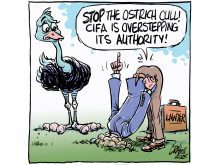Roger Provencher has one sweet job.
The marketing manager not only receives two all-expenses-paid trips to European trade shows each year, but his bosses encourage him to stay on and do some sightseeing.
“After the SIAL food show in Paris last fall, I spent another nine days and toured four different countries while meeting customers,” Provencher says.
“They really want that personal relationship, so they’d invite you to their homes for meals and everything. The only problem is the Germans want to drink beer at 9 o’clock in the morning.”
Read Also

Budget seen as fairly solid, but worrying cracks appear
The reaction from the agriculture industry to prime minister Mark Carney’s first budget handed down November 4th has been largely positive.
Nice work, eh?
Actually, lots of people have jobs like Provencher’s – SIAL alone attracts 5,300 exhibitors and 140,000 buyers from around the globe. What makes his situation different is his bosses: the 200 bison producers who collectively form the Canadian Prairie Bison Co-operative in Shellbrook, Sask.
These are not fat-cat executives with money to burn. So when Provencher first proposed going to Europe two years ago, you can bet he faced a grilling.
“It’s hard for producers to see the marketing side of the picture, especially when you’re saying, ‘Look, it’s going to cost 10 grand to go Europe and see if we can find some markets there,'” he says.
“But it really comes down to the fact that you’ve got to spend a dollar to make a dollar.”
Provencher can see both sides because he was a bison producer until 2003. Like his bosses, he remembers well the heady days of the 1990s when animals were fetching $2,000 or more. He also remembers the breeding-stock bubble bursting, the sudden realization that there was no established consumer market for bison meat, and the sickening plunge in prices.
Canadian Prairie Bison was formed out of necessity in 2001. It’s focused on quality, including natural production methods and a verifiable paper trail, and sought to form alliances with packers, wholesalers and retailers.
And it paid off. Sales hit 2,600 animals in 2006 and is expected to be double that this year. More importantly, prices are nearing the $2 a pound mark, meaning producers can now make money raising bison for meat.
But most of the co-op’s business – 95 percent – comes from the U.S. That prompts the question: why spend all that money going to Europe?
The initial motivation was diversification, but having spent time overseas, Provencher has found a better reason.
“The thing I like about the Europeans is that they love our product and really appreciate it,” he says.
“They have a different attitude towards food than North Americans. I mean, over here, people don’t have a problem spending $60,000 on a pick-up truck, but they won’t pay an extra $1 a lb. for meat.”
The other thing Provencher found is that Europeans love Canada and picture it as clean, natural and unspoiled.
This good feeling means nothing if producers can’t make money, and the cost of sales trips is just the start when it comes to selling overseas.
“Just to get our product over there – after paying your producers, processing and air freight – you need $6 to $7 a kilo ($4 to $4.50 per lb.),” Provencher says.
He won’t say what price the co-op is getting, but noted he’s seen bison tenderloin selling for $60 a lb. in a high-end store.
For commodity producers, selling into well-heeled markets such as Paris, New York City and Hong Kong may seem like, well, a foreign concept. But producers in Canadian Prairie Bison have changed their thinking.
“You can’t do it as individuals, but if you get together as a group and get organized, anyone can do what we’ve done,” Provencher says.
“I don’t think there’s a limit. It could be chickpeas, it could be anything, as long as you’ve got the quality.”
And, he might add, the willingness to spend a dollar to make a dollar.
Glenn Cheater is editor of the Canadian Farm Manager, the newsletter of the Canadian Farm Business Management Council. The newsletter as well as archived columns from this series can be found at www.farmcentre.com.














